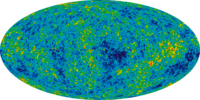
Photo from wikipedia
Features during inflation and reionization leave corresponding features in the temperature and polarization power spectra that could potentially explain anomalies in the Planck 2015 data but require a joint analysis… Click to show full abstract
Features during inflation and reionization leave corresponding features in the temperature and polarization power spectra that could potentially explain anomalies in the Planck 2015 data but require a joint analysis to disentangle. We study the interplay between these two effects using a model-independent parametrization of the inflationary power spectrum and the ionization history. Preference for a sharp suppression of large scale power is driven by a feature in the temperature power spectrum at multipoles $\ell \sim 20$, whereas preference for a component of high redshift ionization is driven by a sharp excess of polarization power at $\ell \sim 10$ when compared with the lowest multipoles. Marginalizing inflationary freedom does not weaken the preference for $z \gtrsim 10$ ionization, whereas marginalizing reionization freedom slightly enhances the preference for an inflationary feature but can also mask its direct signature in polarization. The inflation and reionization interpretation of these features makes predictions for the polarization spectrum which can be tested in future precision measurements especially at $10\lesssim \ell \lesssim 40$.
Journal Title: Physical Review D
Year Published: 2018
Link to full text (if available)
Share on Social Media: Sign Up to like & get
recommendations!